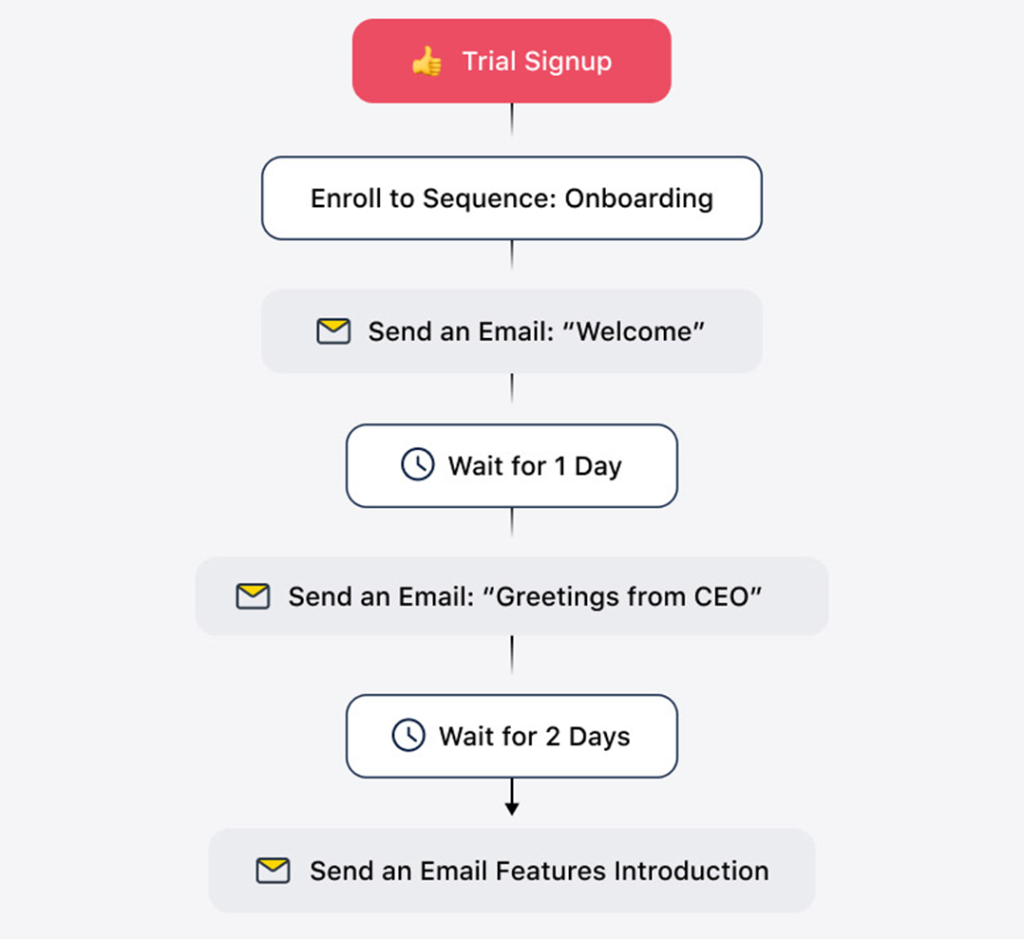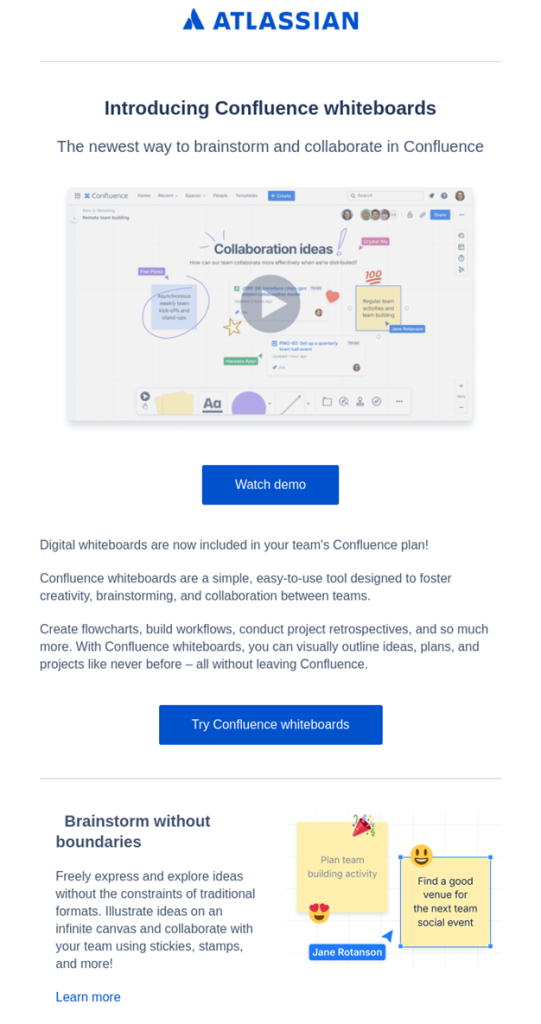- Home
- Targeted Tactics
- SaaS Email Marketing: Strategi ...

SaaS email marketing is the crucial digital medium for companies, as they can interact one-to-one with their audience. Do you know that well-written and structured emails generate $36 in profits for every dollar spent? That’s a whopping 3600% ROI.
That’s why the importance of email marketing for SaaS businesses can’t be ignored. It is a powerful tool to support growth across the sales funnel, from lead generation and nurturing to customer retention and support.
But before we share examples to help you craft a perfect SaaS email marketing strategy, let’s define what email marketing is for SaaS.
What Is Email Marketing for SaaS?
Email marketing for SaaS companies involves using emails to communicate with current and potential customers at every stage of the customer journey to encourage them to convert to your service.
It’s about sending the right message to your audience at the right moment in their experience with your service. This type of nurturing helps SaaS companies guide leads through the process from initial consideration all the way through renewals. Communicating at critical touch points lets companies address questions, showcase value, and gain insights that allow personalized connections at each stage.
How SaaS Email Marketing Stands Apart from Other Types of Email Campaigns
SaaS email marketing differs from other types of email campaigns in several key ways:
- Ongoing engagement: SaaS companies aim to build lasting bonds with their customers, often through subscription models. In other words, unlike one-time product/service purchase, this will be an ongoing engagement, and the email campaign must focus on keeping users active. With ongoing relationships as the goal, their messaging must provide useful updates while strengthening positive associations over the long run.
- User onboarding: SaaS emails frequently include helpful “getting started” series to guide new users through onboarding smoothly. These messages can take new customers step-by-step through account setup, interface orientation, core capabilities introduction, and more. The goal is to make them feel comfortable and capable with the service right from the get-go. Individualized email sequences tailored to each new subscriber’s profile streamline the learning process.
- Feature updates: Research by HubSpot revealed new product and feature announcement marketing emails have the highest click-through rate for B2B marketers. Indeed, regular feature releases and fixes are common in SaaS, so email is vital for keeping existing users informed about enhancements. Whether it’s functionality additions or performance upgrades, keeping a pipeline of progressive communication maintains engagement and encourages exploration of the latest offerings.
- Subscription renewals: Addressing subscription cycles is also crucial. These emails will help SaaS companies remind about upcoming renewal dates, review account benefits clearly, or pitch relevant upgrades, ultimately working to retain long-term customers by proving ongoing worth. It’s about finding that sweet spot of information without coming across as too salesy.
- Customer support: Additionally, emails can sometimes serve as a minor support function. For example, they briefly answer typical questions through targeted FAQ content, provide maintenance notifications, or direct users where to find proper troubleshooting resources. The goal is to make access to assistance smooth and maintain a positive experience.
- Technical crowd: Many SaaS products cater to a tech-savvy bunch, requiring specialized content. This demographic also expects attention to modern formatting and design that ensures usability across various devices and platforms.
Why Is SaaS Email Marketing More Difficult?
While email is widely used for SaaS marketing, it certainly has its own challenges to overcome:
- Complex products: It’s no simple task explaining complex software solutions succinctly through email marketing. With so many tools and features to potentially cover, SaaS companies face a real challenge distilling everything down into compelling highlights.
- Diverse user base: Reaching customers throughout their journey also demands nuance. Crafting messages that resonate no matter where someone is in the process requires truly understanding differing perspectives.
- Rapid product evolution: And in an industry that innovates so rapidly, keeping content fresh is a constant effort. Integrating the latest updates without overwhelming your users takes real finesse. Frequent updates and new features mean email content must be constantly refreshed and aligned with the latest product offerings.
- High competition: The SaaS market is crowded; breaking through saturated inboxes to engage tech-savvy audiences adds another layer of difficulty. Gaining their attention when they see marketing for what it is isn’t easy.
- Technical audience: Many SaaS products cater to technical users who may be more discerning about marketing messages.
SaaS email strategies require careful calibration. While email remains a powerful tool, it’s evident why the balancing act deserves nuanced attention. With thoughtful targeting and presentation, many of these hurdles can certainly be cleared.
Why Is Email Marketing Important for SaaS?
Despite its challenges, email marketing is crucial for SaaS companies for several reasons:
- Cost-effective: Compared to other marketing channels, email marketing offers a high ROI.
- Direct communication: Email provides a direct line to users, otherwise quite difficult to achieve. Being able to personalize each message based on individual needs, wants, and journey speaks volumes. That kind of relevance and meaningfulness cultivates genuine relationships over time.
- User retention: Regular engagement through email can significantly reduce churn rates. Making the effort to regularly engage clients through tailored emails does wonders for retention.
- Upselling opportunities: Email is an effective channel for promoting upgrades and additional features. It is one of the best mediums to promote additional features that could take a product to the next level. It’s the perfect low-pressure way to spark new possibilities.
- Data collection: When users interact with emails, they leave digital footprints that can be analyzed to gain insights. Here’s a breakdown:
- Open rates: Tell you which subject lines are most effective and when users are most likely to engage with your emails.
- Click-through rates: Indicate which content or offers are most interesting to your users.
- Time spent reading: Can suggest how engaging your content is.
- Device and email client information: Helps you optimize your email design for different platforms.
- Link interactions: Show which features or aspects of your product users are most interested in.
- Unsubscribe rates: Can indicate when users are losing interest or if certain types of content are not well-received.
6. Scalability: Email campaigns can easily scale to reach a growing user base. As your audience expands, you can easily use automation to handle your increasing workload and integrate with CRM tools to scale your marketing efforts without compromising on personalization or effectiveness.
7 SaaS Email Marketing Strategies
- Implement a strong onboarding sequence.
- Create a series of welcome emails that guide new users through key features.
- Use interactive elements like videos or GIFs to demonstrate product functionality.
- Set clear expectations and provide quick wins to encourage continued use.
- Segment your email list.
- Divide your user base based on factors like usage patterns, subscription tier, and engagement level.
- Tailor content to each segment’s specific needs and interests.
- Use dynamic content to personalize emails at scale.
- Focus on value-driven content.
- Share case studies and success stories to showcase the product’s impact.
- Provide tips and best practices to help users get more value from the software.
- Create educational content that addresses common pain points in your industry.
- Utilize behavior-triggered emails.
- Set up automated emails based on user actions (or inactions) within the product.
- Send re-engagement emails to dormant users.
- Congratulate users on achieving milestones or completing key actions.
- Implement a robust re-engagement strategy.
- Identify at-risk users and create targeted win-back campaigns.
- Offer incentives or limited-time offers to encourage renewed engagement.
- Use social proof and FOMO (fear of missing out) to highlight what users are missing.
- Leverage product updates and feature announcements.
- Create excitement around new features with teaser emails and countdown sequences.
- Provide clear, benefit-focused explanations of how updates improve the user experience.
- Offer exclusive beta access to engaged users for upcoming features.
- Implement customer feedback loops.
- Regularly solicit feedback through surveys and questionnaires.
- Act on feedback and communicate changes back to users.
- Use NPS (Net Promoter Score) surveys to gauge overall satisfaction and identify promoters.
3 Successful SaaS Email Marketing Examples
Here are a few great SaaS email marketing examples for every purpose.
1. Zapier promotional email showcasing a limited-time offer
This promotional email from Zapier effectively showcases a limited-time offer for their professional plan, likely aimed at converting free users to paid subscribers. Key elements include:
- A concise explanation of the offer: 3 months for $10, plus applicable taxes.
- Bullet points outlining key features of the Professional plan: unlimited premium apps, conditional Zaps with Paths, advanced Zap settings.
- A prominent “Try a Professional plan” call-to-action button.
- Detailed offer terms, including: offer end date, regular pricing after the promotional period, mention of support for local currencies.
The overall messaging stays concise yet demonstrated real value — Zapier is lowering the barrier to entry for their more advanced plan, potentially leading to long-term conversions once users experience the added capabilities.
2. Atlassian’s email announcing a new feature
Atlassian’s recent email rollout highlighting their Confluence whiteboards is right off the bat. Key elements include:
- The headline “Introducing Confluence whiteboards” is concise and benefit-driven.
- The visual demo is compelling and truly shows the feature’s potential.
- Clear calls to action and focused value propositions.
- Supporting visuals and icons keep messaging sharp yet playful.
The overall messaging is clear and highlights the capabilities and benefits of the new feature. All in all, the message strikes a balance between information and encouraging user engagement.
3. Stripe’s email on billing challenges
This email is an informational piece rather than a direct promotion of Stripe’s services. It also positions the company as a thought leader and builds trust and credibility. Key elements include:
- Thoughtful headline that tackles a critical SaaS pain point.
- Sleek design, helpful illustrations, and a calming palette making the message more insightful than pitching.
- Offer of valuable industry insights via a downloadable report.
- Credible statistics that highlight the importance of the issue in discussion.
This email is an effective example of how to nurture prospects while adding value, potentially leading to future conversions.
To Sum Up
Successful email marketing in 2025 requires that SaaS companies take a focused approach to showcasing their service value, personalization, and continuous engagement. SaaS companies can draw inspiration from successful strategies and examples we have explained above and leverage email marketing to drive growth, retain customers, and stay ahead in a competitive market.







